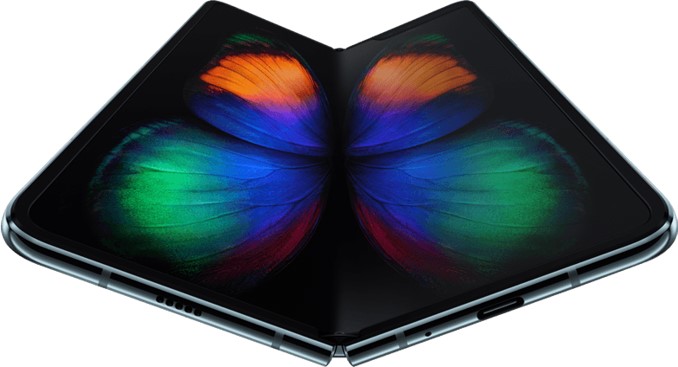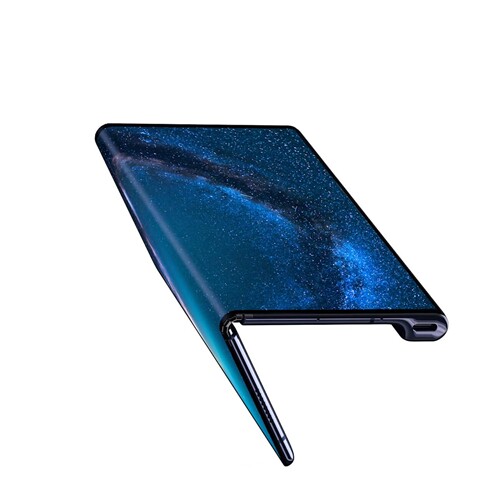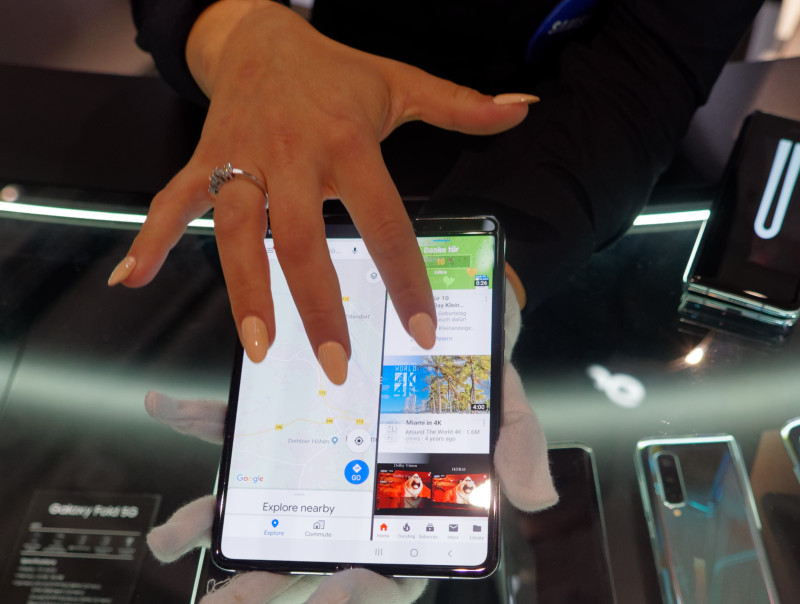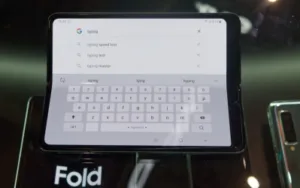Samsung Electronics re-launched its Galaxy Fold smartphone at IFA 2019 in September. Other brands have also joined in to introduce many different design concepts of foldable smartphones with OLED display in different sizes and formats.

Foldable smartphones and 5G-technology received strong attention at IFA as high transmission speed and low latency are expected to drive innovative products and boost demand in a slow smartphone market. There are still many issues that need to be resolved before consumer acceptance – extremely high prices, no standardization in design, robustness and durability. Innovations in the display materials and processes will continue to bring better products and reduce costs.
Many designs, sizes and prices
Royole’s FlexPai has the distinction of being the first foldable smartphone to be introduced at the end of 2018 at around $1,300 price. Samsung introduced the Galaxy Fold in early 2019, but delayed shipments due to some hinge and film issues; then the firm reintroduced it again with a new version at IFA this month. Samsung’s Galaxy fold is a 5G foldable (AMOLED) product with a front cover 4.6” display and 7.3”main display and expected to be priced around $2000 (I was told €2,100 at IFA – Editor).
The Huawei Mate X is a 5G foldable OLED smartphone that has an 8” main display that can fold to 6.6” on the front side and 6.38” display on the back with an expected price of $2600. Other smartphone suppliers such as TCL, Oppo, Vivo, Xiaomi, and Lenovo are expected to introduce their products in the future. Apple has not announced any plan for foldable iPhones, but is expected to make an introduction in 2020. With very high prices, a lack of standardization, and concerns about durability, foldable smartphone products will have very limited shipments in 2019.
 The Samsung Galaxy fold
The Samsung Galaxy fold
Higher requirements for displays
Commercialization of foldable smartphones up to now has been based on foldable AMOLED (active matrix organic light emitting diode) display technology. For a foldable display, all the layers within the panel should be foldable, durable, and transparent with a total bending radius of less than 1.5 mm. That is why new components are needed for foldable OLEDs. Foldable requirements are as follows:
- Cover windows need to have hybrid organic/inorganic coating on transparent polyimide (PI)
- Polarizer needs to be thin and bendable
- Flexible touchscreen needs non ITO materials such as silver nanowire or metal mesh
- Need for Flexible Adhesive OCA/OCR
- Reliability (to withstand more than 200K times bending/folding).
Bendability has a trade off with durability and robustness. Bending of a very thin film after a certain point can generate a crease or lead to deformation. The display industry has developed numerous materials and processing challenges to balance bendability with durability. However significant challenges still remain.
Complexity in In-fold and Out-fold Design
New designs for foldable smartphones still have many issues with foldable hinges, flexible covers, increased thickness and bulkier designs. Samsung’s Galaxy Fold is in-fold design while Royole’s FlexPai and Huawei’s Mate X are out-fold. Xiaomi’s future product is expected to be be based on a double-fold concept. Lenovo’s future product is expected to fold vertically in the middle. Samsung is apparently working on out-folding and vertically mid-folding designs to introduce in the near future.
The in-fold design has the advantage of better protection of the inner display, but there are disadvantages from having two displays, including a need for higher battery capacity, higher thickness and may be even higher costs.
Out-fold designs have the advantage of single display for both a phone cover and tablet display, but the disadvantage of the display screen being exposed to the outside, so it is easy to scratch or damage. Therefore a foldable cover window has to be integrated with a scratch or abrasion resistant function.
 Huawei’s Mate X
Huawei’s Mate X
Balance of bendability with durability for cover window
The biggest challenge for a foldable smartphone is replacing the glass cover with plastic film. Glass is strong, durable and hard to scratch. The cover plastic film needs to be mechanically durable to withstand more than 200K times folding/bending as well as be scratch resistant. In an out-folding design, the cover film must provide protection as well as endure the highest level of tensile strain during the out-folding condition. It needs more than a 9H pencil hardness for the flexible cover film. Samsung is using transparent polyimide (PI) for the cover film instead of glass for the Galaxy Fold.
Corning is currently working on developing an ultrathin and durable glass solution for foldable displays that can bend at a tight radius – hundreds of thousands of times without significant damage at the fold. The product is still in development and company is working with customers to optimize the product for design requirements. Ultra thin glass that can get to a very thin tight radius also has to be able to survive drop and resist damage.
Asahi Glass (AGC) is also working on flexible glass for folding smartphones. Suppliers are expecting ultra thin glass for foldable products in one to two years. If a glass solution can balance bendability with robustness for foldable display, it could resolve many durability challenges.
Different requirements for Foldable Touch Screen
Smartphone touch screens generally use glass cover lens and touch sensors made from Indium Tin Oxide (ITO). Touch sensitivity depends on proximity of the sensor to the finger and materials in the display module.
According to inputs from the Fieldscale company, glass has a significantly higher relative permittivity (?=5-8) than plastic and adhesives (?=3-4)). That means that a touch sensor can tolerate relatively thick glass cover up to and exceeding 4mm, but plastic covers above 2mm can experience inferior touch performance. ITO for flexible displays can create some issues – processing beyond 200 degrees temperature, ITO can display poor electrical conductivity and transmittance.
To reduce problems from this issue, touch suppliers have turned into ITO alternatives such as Metal Mesh and Silver Nanowires (AgNw). Metal Mesh has a typical bend radius of 4mm, but it can face challenges such as production imperfections (in printed metal mesh) and poor optical performance. Silver Nanowires are solution-coated on films and left to dry. After the drying process is complete, a random pattern of silver electrodes emerges. High performance silver nanowire-based devices need to optimize this pattern and that can create challenges. Silver Nanowires can provide high flexibility. Fieldscale has simulation software that can create a virtual prototype of the whole design to provide answers relating to touch sensor questions.
Foldable OLED display supply
In general, foldable AMOLED display yield rates are significantly lower than general flexible OLED smartphone displays due to complex requirements. Samsung Display, BOE, Royole and LG Display are all working towards developing dedicated capacity for foldable displays in the future. As the foldable market gains momentum, other flexible OLED suppliers such as Visionox, China Star, Tianma may also join in with dedicated foldable display capacity in 2020. AUO is also expected to focus on foldable display in future. Supply will increase in the next two to three years. Improvements in yield rates and material costs can reduce costs and increase production volume in the future. High costs and complex manufacturing issues will limit unit shipments for foldable OLED displays in the near future.
The potential future of next generation foldable displays is promising, but there are many challenges including extremely high price, higher costs, design issues, durability issues, design acceptance by consumers and consumer’s willingness to pay higher prices for new designs. Innovations in materials and processes will help foldable smartphones evolve in the next few years in design, production, and shipments. – (SD)
Sweta Dash is the founding president of Dash-Insights, a market research and consulting company specializing in the display industry. For more information, contact [email protected] or visit www.dash-insight.com
Analyst Comment
I had the chance to have a short look at the Galaxy Fold at IFA. The sample I saw looked very good although where the fold was seemed clear – although the display performance was not compromised – it was slightly different reflections, I think – but it was only a quick look. I would still be very nervous paying so much for a device that could be easily damaged in the pocket if it is closed with something in between the two halves. Two of my photos are below. (BR)
 The Galaxy Fold at IFA – Image:Meko
The Galaxy Fold at IFA – Image:Meko
 The Galaxy Fold at IFA – Image:Meko
The Galaxy Fold at IFA – Image:Meko

